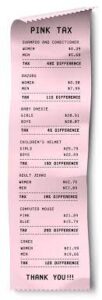
How much does it cost to be a woman? The exact amount is unknown; however, due to the “pink tax,” products marketed toward women on average cost 7% more and up to 50 percent more than comparable items marketed to men.
The “Pink Tax” is a non-government-issued markup by manufacturers and companies on goods and services marketed to women and girls for similar products and services used by all genders.
The pink tax has its name because the standard color used on products that have the tax embedded in their prices are often pink, being that the color pink is commonly associated with females. Products marketed toward men are more often a shade of blue, black or grey.
States such as California, New York, South Dakota, Connecticut and Florida have conducted studies and released reports about gender pricing in their respective states.
In 2015, the New York City Department of Consumer Affairs compared the prices of 794 products from 91 brands sold throughout the city. Their findings concluded that female consumers pay more money for similar products 42 percent of the time, whereas men pay more 18 percent of the time.
According to the finding from the study, toys marketed toward girls cost more 55 percent of the time, while toys marketed toward boys only cost more 8 percent of the time.
Women’s clothing costs more 40 percent of the time, and men’s clothing costs more 32 percent of the time.
Senior home health care products cost more for women 45 percent of the time and more for men 13 percent of the time.
At a local Tallahassee Walmart, three-count pack of three-blade razors with black and green packaging costs $3.48, while a three-count pack of three-blade razors with pink and white packaging was priced at $5.68.
Though different brands produced the razors, they both have the same number of razors and the same blade counts, and they are both marketed as “sensitive” razors. Furthermore, there is a 4-count men’s pack of razors directly next to the 3-count pack for the same price as the 3-count. Which is even more of a price imbalance for the three-count women’s razor.

Jasmine Welch, a 21-year-old college student, says that these findings did not shock her in the slightest.
“This pink tax shows just how gender inequality is still a major issue to this day. Regardless of the fight that we face head-on, there are always going to be some under-the-table regulations that try to hold us back as women. Equity vs. equality — no matter how much adversity a woman faces or the contributions we make to society, we’ll never be seen on the same equitable level as men,” Welch said.
Corporations and local government systems are making strides to eliminate the pink tax. This month, CVS dropped its prices on feminine hygiene products by 25 percent. It also has vowed to fit the bill on tampons, liners, menstrual pads and cups in 12 states — Georgia, Hawaii, Louisiana, West Virginia, Arkansas, Missouri, Texas, Tennessee, South Carolina, Tennessee and Virginia.
The pink tax sometimes is referred to as the “tampon tax” when examining the amount of money feminine hygiene companies expect women to spend to accommodate their monthly menstrual cycle.
Caleb Shelton, 21, said he was shocked to hear that gender inequality was even ingrained in everyday products.
“It’s unacceptable. At the end of the day, for women to spend more based on their gender doesn’t make sense. It’s a lot that y’all deal with already, and women are already paid less as it is,” Shelton said.
California recently passed legislation that is expected to eliminate the pink tax completely. Assembly member Rebecca Bauere-Kahanm authored Assembly Bill 1287, prohibiting companies from charging different prices for products based on gender.
Governor Gavin Newsom signed the bill into law on Sept. 27. Companies that fail to follow this law may faces thousands of dollars in fines.
Whether it’s a razor, a shirt or a toy, the pink tax is an almost inescapable financial burden that follows women and girls throughout their lifetimes. From the cradle to the cane, the pink tax has been estimated to cost women approximately $135,100 in their lifetime.